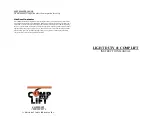
3
should be replaced prior to further use of the heater. Plugging heater into a worn outlet/ receptacle may
result in overheating of the power cord or fire.
16. Ensure the heater is on a stable, secure floor surface to eliminate the potential of tipping it over.
17. Be sure that the plug is fully inserted into appropriate receptacle. Please remember that receptacles also
deteriorate due to aging and continuous use: check periodically for signs of overheating or deformations
evidenced by the plug. Should this occur, do not use the receptacle if deteriorated. CALL your electrician.
18. Check that neither the appliance nor the power cable has been damaged in any way during transportation.
19. Make sure that no pieces of polystyrene or other packaging material have been left between one element of
the appliance and another. It may be necessary to pass over the appliance with a vacuum cleaner.
20. When switching on the appliance for the first time, you may notice a slight odor which is normal with new
electrical appliances. Allow odor to dissipate by running appliance at full power for about ten minutes. Make
sure that the room in which the appliance is located is well ventilated during this operation. This heater
draws 23.3 Amps during operation. To prevent overloading a circuit, do not plug the heater into a circuit that
already has other appliances working.
21. Do not run in locations when the heater will be left unattended for long periods of time. (For example - in an
unoccupied summer cottage).
22. Do not use attachments or filters. They are not recommended.
23. Always plug heater directly into a wall outlet/receptacle. Never use with an extension cord or relocatable
power tap (outlet/power strip). A heater has hot and arcing or sparking parts inside. Do not use it in areas
where gasoline, paint,or flammable liquids are used or stored.
SAVE THESE INSTRUCTIONS
WARNING
– RISK OF FIRE, DO NOT USE AS A
RESIDENTIAL OR HOUSEHOLD HEATER
CAUTION
: This appliance is not intended for use by persons (including children)
with reduced physical, sensory or mental capabilities, or lack of experience and
knowledge, unless they have been given supervision or instruction concerning use
of the appliance by a person responsible for their safety.































